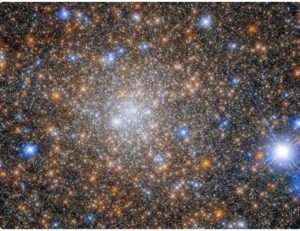
The Terzan 1 globular cluster. (Image credit: ESA/Hubble & NASA, R Cohen)
The Hubble Space Telescope has captured an image of the Terzan 1 globular star cluster, which is about 22,000 light-years from the Earth in the direction of the constellation of Scorpius, located in the southern celestial hemisphere.
Hubble is on a campaign of imaging globular clusters towards the centre of the Milky Way, and gas previously captured NGC 6638, NGC 6540, NGC 6558, Liller 1, Terzan 2, Terzan 4, and Terzan 9. Terzan 1 is about 150 globular clusters in the Milky Way. A typical globular cluster has about a hundred thousand stars held together by their mutual gravity, and contain among the oldest and reddest stars in the galaxy.
There are 11 Terzan globular clusters, numbered from Terzan 1 to Terzan 12. In 1971, when Turkish-Armenian astronomer Agop Terzan re-discovered Terzan 5 in 1971, numbered it as Terzan 11, and published the discovery alongside those of Terzan 9, Terzan 10 and Terzan 12. He attempted to correct his mistake by renaming Terzan 12 to Terzan 11, but did not make it clear that Terzan 11 and Terzan 5 were both the same star cluster. Terzan 12 is now accepted with its original number, and so is Terzan 5, with scientists accepting the oddity of a lack of a Terzan 11. However, the missing cluster has led to confusion in scientific literature in the past.
The bright blue stars seen in the image are foreground stars, not part of the globular cluster. By investigating globular clusters and the age of their stars, scientists can piece together a timeline for the evolution of the Milky Way. Terzan 1 is a source of X-rays, like many globular clusters, probably originating from binary star systems made up of a regular star and a neutron star. The neutron star feeds on material from its companion, and emits X-rays. The Hubble Space Telescope has previously imaged Terzan 1 in December 2015




 Driving Naari Programme launched in Chandigarh
Driving Naari Programme launched in Chandigarh






























